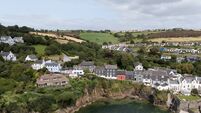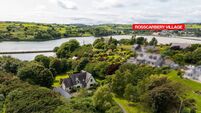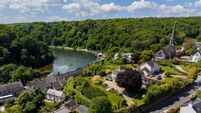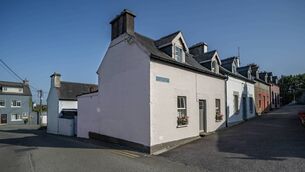Nohoval mill conversion yields coastal comfort down by a cove

Despite being launched in 1914 with the dashing name of El Zorro, the 6,000 tonne vessel was sighted and sunk by a prowling German U-boat on December 28 ending the same year as the famous Lusitania when it went down off the same south coastline, beyond the Old Head of Kinsale, a sinking with 1,200 souls lost that triggered the US’s entry into WW1. It’s all a bit apposite for historic Nohoval’s Mill setting, with its craggy rocks, outcrops of sandstone shard and forbidding cliffs.
This mill building, now resuscitated and back to rude health, is just a few hundred yards from what’s essentially a private beach, with the evocative title of Man of War Cove (also called Smugglers Cove by some locals). Set between Ringabella and Oysterhaven, or on a slightly wider chart, between Cork harbour’s Roches Point lighthouse and Kinsale’s Old Head lighthouse, with the ocean-bed all along littered with shipwrecks over the past several centuries.

Back when this three-storey flour mill building was built (a Famine project?) in the 1840s, nearby Nohoval Bay witnessed one poignant ship loss, when the Eliza Mary carrying corn from Youghal to Clonakilty foundered in March 1847: the bodies of two small children were washed up on the rocks near here from that work-a-day boat’s last trip.
You’ve got to think of things like that in such a setting; where history is within the very walls of buildings. “We bought a ruin,” say the family living at The Mill, Nohoval for almost 20 year now. And, they have the pictures (see middle pic, right) to prove it. Oftentimes, people who do up older houses, or convert churches, schools or extend cottages may exaggerate the work they had to undertake. ‘Trees growing out the roof’ is a bit of a conservation cliche, though the image is evocative.

Back in 1994, The Mill had trees in its base, but there wasn’t a roof to poke through: the owners reckon it was taken of in the early 1990s, possibly to save on rates bills. So, by the time the house hunting couple, with two tiny children, found themselves in the copses and briars by Man of War Cove, this building was in a truly sorry state.
It hadn’t even been for sale, but they asked the local Roberts family if they’d consider selling? Several months later they got an affirmative: it could be bought, and saved. They wrestled the wreck, on two acres of glenside woodland with its stream and ponds that used to power the mill wheel to grind the corn for flour, and in their own heroic rescue mission, made it over to a private family home in an exceptional setting down a leafy glen avenue.

It took two years, with well-able builders the Keohanes, and the result of their initiative and labours is here for all to see. If you can find it, that is. Now for sale with Lawrence Sweeney of Savills, Nohoval’s The Mill is hidden within private farm fields and woodland along Nohoval’s headlands. It’s in a valley dip down running down to the sea, a mile or so east of popular Nohoval Cove with its diving rocks, and nearby are Rocky Bay and Roberts Cove. For further reference, Carrigaline’s about nine miles away, and Kinsale’s a 20-minute drive. The Mill’s an imposing building, and an even more remarkable conversion carried out by Jim and Jackie McClay at a time when their two children were babies.
Today, the house is full of photos of kids on beaches, kids buried in sand, kids in the water, in boats, and up in the trees. It was, they admit, an extraordinary setting in which to rear free-range children. The Mill, and Man of War Cove, of course proved hugely popular with their friends, and sleep-overs were common with beach parties beckoning. Why would you not have a picnic on the beach, when the glen walk to the sea is so short, a mug of tea still steaming hot when you get there? Just in case the building’s own comforts and charms aren’t enough to woo new owners, the beach’s proximity will be a clincher for those who crave an outdoors lifestyle.

The shingle cove (there’s a few sandy bits) is also home to a small old disused boathouse, with rusting remnants of a winch for hauling up larger craft. Yards away is a ruin of an old small folly, where ladies of leisure sat and sipped tea, gazing at the sea, east towards Power Head and Ballycotton. It’s all entirely evocative, and usually isolated, though it can be visited from the water by those who brave the cove’s rocks and reefs.
The land by the beach doesn’t come with the sale but there’s a right for way along the luscious green path by the the stream that powered the mill’s original wheel. Today, part of that wheel and axle are in the private grounds and by the added stable and tack room in front of what’s now a fine, and imposing, stone home, and the McClays surmise the mill may have gone of out of active use a century or more ago after that shaft shattered.

Savills Estate agent Lawrence Sweeney says of the two-acre hideaway “it’s truly unique, with its size, setting, finish, beach and total privacy.”
He’s had an encouraging stream of inquiries since it went to market in August. He guides it at €650,000, but reckons it could get more when bidding gets going: it’s the sort of place once someone’s hooked, they’re not likely to let it go too easily. Already, one or two have come back for a second viewing, (no offers yet,) and the interest is far-flung. There’s been local Cork inquiries, but calls too from far further afield, and several UK home-hunters have flown over for a look-see.
There’s a huge romantic feel to the place; it could as easily be set in Cornwall/Penzance: in fact, depending on flight paths, planes coming in to land at Cork airport will track this section of craggy coastline, and get a final flight path bearing around Nohoval.

Despite its industrial past, the interior feels entirely domestic, and its walls are blessed with lots and lots of windows, all now made up in timber sash frames with double glazing.
There’s a five-bay front, facing east to the sea, over three levels and a wide, arched double-door entrance to lower ground level, central entrance hallway. The house, over 2,400 sq ft, has a peculiar feel of getting larger the higher up you go, and it’s no optical illusion, as the stout walls narrow the higher up they go.
It’s on a stepped site, so the middle level opens directly to a raised garden with a west-facing rear stone-flagged terrace, fringed by the steam, a background gurgle in summer and a bit more of a spate in winter after heavy rains. It all runs nicely away from the mill building now, and much of the original ponds are part of the lush garden, an essay in forty shades of green, with what looks like a sunflowers or daisies for a blast of colour in its midst.

Stacked here are rings of trees being dried out for wood burning in one of the house’s large stoves: there’s more wood to hand than you’d even need to heat the place, and although the sun’s a rare visitor in the glen’s depths in winter, the owners say it’s always a warm home.
The family used old architectural salvage for its domestic conversion. Its ground level is home to a kitchen with reconditioned two-oven Aga, with pantry, and across the tiled hall is a dining room, with a very large oil-fired cast iron stove.
A graceful curve of Portland stone steps, salvaged from the original Hoddersfield House near Fountainstown, starts the stairs up to middle/first floor, which is home to a 17’ by 14’ living room with tall ceiling.
In contrast to the ground level where walls were dry-lined and finished in smooth plaster, the walls upstairs have been left in their stone state, painted a soft shade of grey. There’s a warm-feeling here in autumn sunshine, with a large central landing, bathroom and two bedrooms, and views improve the higher up you go.
The top deck here is home to three more bedrooms, two with en suite bathrooms, and feature pitch-pine timbers up here with odd cut-outs were salvaged from an old church. There are, at best, glimpses to be had of the sea at Man of War Cove from some of this top-most floor’s windows.
Ship ahoy.
Flour power personified.
Nohoval, Cork €650,000
Sq m 223 (2,400 sq ft)
Bedrooms: 5
Bathrooms: 4
BER Rating: Exempt
Pictures: Denis Scannell














